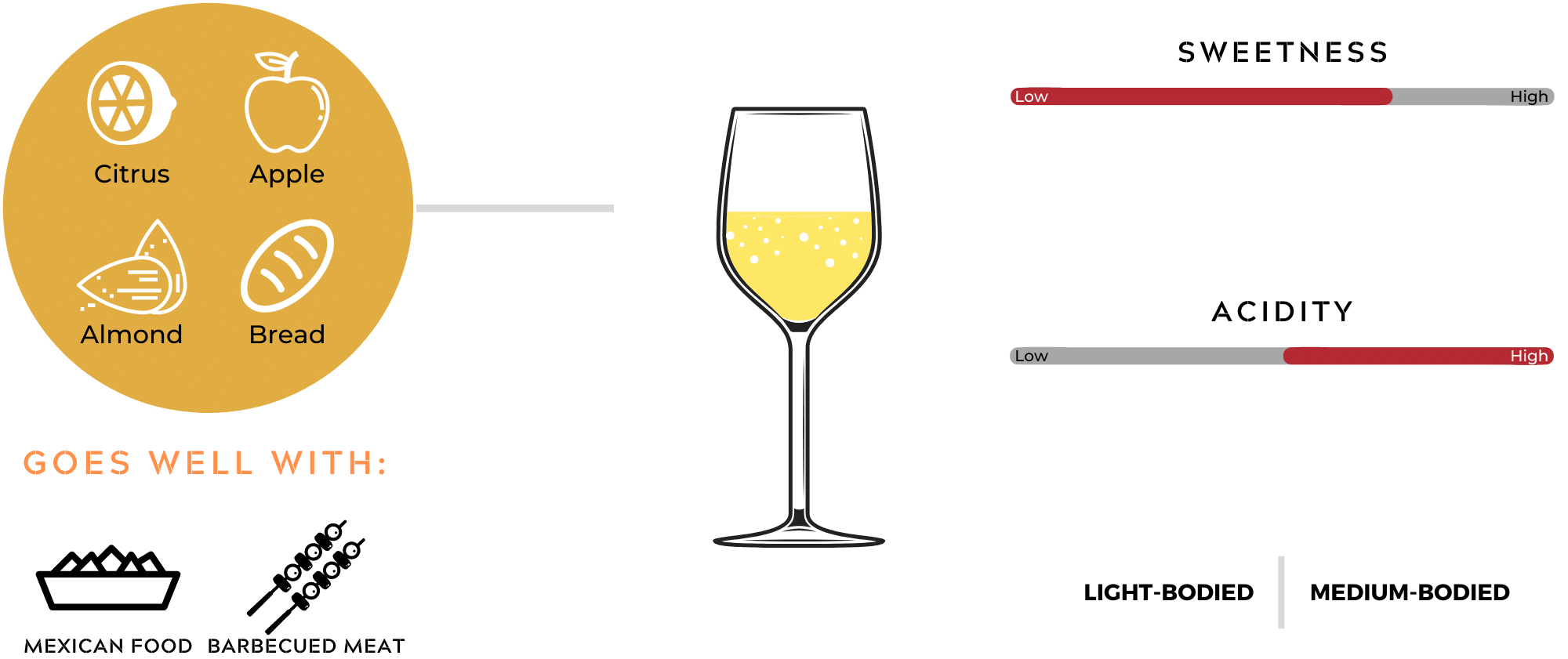Sparkling wines are a relatively recent invention in the world of wine, with the first recorded types of it first being mentioned from historical records that existed in the 16th and 17th centuries.
Whilst many will be familiar with the extremely popular and famous Champagne sparkling wine from that region in north eastern France, there are actually quite a few different types to consider when looking to venture into the category.
In this guide, we focus on some of the lesser-known but still widely available styles of sparkling wine for those who wish to discover more about how they taste and how they can be best served alongside food.
Jump to a section of the page using the jump-to-section menu above, otherwise be sure to consider the other wine guides available through the main menu above, for those who wish to explore more about Champagne and prosecco.
Asti spumante is a sweet style of sparkling white wine produced in Italy from the moscato bianco grape, although other examples of this style can be produced elsewhere but are typically labelled sparkling moscato.
Producers in Italy use the tank fermentation technique in making this sparkling wine and it is famous for its sweet taste and low alcohol (generally around 7.5%).
These wines are aromatic in style, characterised by a refreshingly moderate level of acidity, high sweetness, and light-body, with prominent flavours often including oranges, honey, and light citrus.
When pairing with food, it is often best consumed alongside fruits, fruit salads, fruit-based desserts, or fruit infused cheeses.
Cava represents the Spanish take on premium sparkling wine, with this dry sparkling wine being made using the same traditional method employed in the production of Champagne.
Cava winemakers, however, use a different selection of grape varietals and are known for ageing their wines for slightly lesser amounts of time on the lees, which are essentially dead yeast particles that are responsible for imparting nutty and bready flavours in wine, than producers of Champagne, making their wines taste a little more fresh and less doughy or bready.
Although some bottles of Cava can have high levels of sugar and sweetness, the most premium and aged examples are dry in their style, high in acidity, and light to medium bodied.
Because of its generally crisp and refreshing levels of acidity and flavours of citrus, apples, nuts, and bread, these wines pair wonderfully with Spanish tapas courses, Mexican food, and barbecued meats.
To discover more about this wine style, read this thorough guide to Cava wines.
Crémant is a style of dry sparkling wine mostly produced in select regions of France, although it is also produced in neighbouring Luxembourg.
These wines are made in almost the same style as their French counterpart Champagne, although Crémant wines are known for their creamier texture and typically lighter, sometimes floral, flavours.
Each of the seven Crémant producing regions in France impart their own influences on the flavour profile of the wine due, in large part, to the varying rules and regulations regarding the wines production in each region.
Although these wines can be made in varying styles, they are typically high in acidity, light to medium bodied, and dry to semi-dry, making them perfect for matching with salty or fried foods, and soft cheeses.
This site offers a closer look into the world of Crémant wines.
Although not defined by a set style, region, or production method, sparkling rosé wines can easily be identified through their salmon pink to red colouring.
Most commonly, sparkling rosé wines gain their distinctive colour from a production method called the maceration process, where the base wine is allowed to rest with the skin of the grapes for some time before it is then filtered to remove the solids and taken through the same process as other sparkling wines.
Another method is the saignée method, which takes the juice of a normal red wine undergoing fermentation and uses this to produce the base rosé wine used.
Finally, and famously used in the production of Rosé Champagne, the winemaker can blend white and red wines together to produce a lightly pigmented sparkling wine.
Although difficult to categorise all sparkling rosé wines into one select flavour profile, they tend to possess flavours typically found in other sparkling wine varietals but with extra layers including flavours and aromas of strawberries, raspberries, and other red fruit.
These wines can often be paired wonderfully with fried or fatty foods, barbecued meat, and finally, creamy risotto dishes.
There's a bottle of sparkling wine out there for everyone. Here are some of the brands and bottles that we recommend you look out for the next time you're browsing online or in-store.
Learn how to pick the right bottle of Gewurztraminer wine for you and your tastes when browsing online or in-store in our beginners guide to the style with graphics.
With bottle shops expanding their range, we’ve taken the time to explain why some wines are and some are not vegan & organic in order to help you choose wisely.
Ready to begin your journey into the world of wine but don’t know where to start? Here’s our primer on what bottles & styles to try when just starting out.



